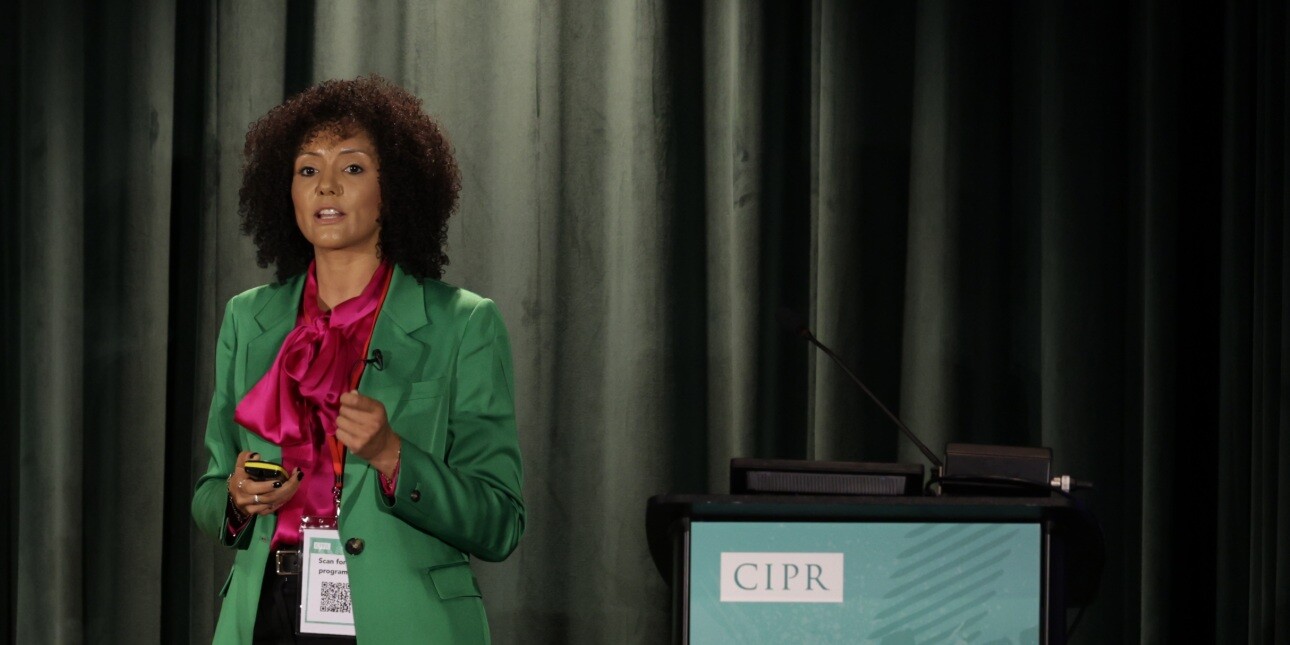The CIPR annual conference 2025 reviewed: leadership and impact
More than a dozen leadership experts took to the stage in London as the future of strategic communications came under the spotlight at the CIPR’s annual conference.
Around 300 PR and communications professionals descended on the Minster Building near Tower Bridge on Thursday for the CIPR’s annual conference, which this year was themed around leadership and impact.
With practitioners also joining online, delegates heard from speakers whose expertise stretched across AI, change management, marketing neuroscience, confidence and other specialities that are vital for comms professionals to understand.
The conference promised to help PR practitioners drive business outcomes in a world where trust, reputation, and influence are paramount. All the speakers delivered practical advice on how PR professionals can achieve this irrespective of their age or sector.
The pressures facing PR and communications were clear: uncertainty is now the norm, while fear and anxiety will be a constant. Comms pros and leaders wanting to successfully grow their organisations will need vision, empathy, confidence and the ability to switch off, the experts advised.
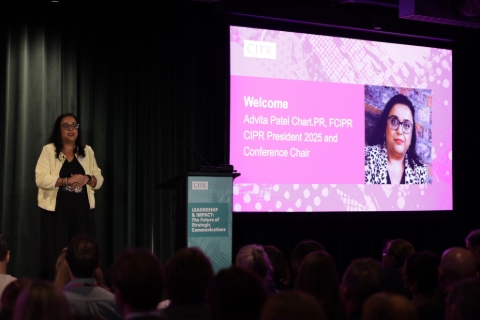
“I’m reminded that leadership isn't a title that we inherit,” said Advita Patel, the CIPR President 2025 and conference chair. “It's a behaviour that we must practice day in, day out, and the impact we have comes from the clarity that we offer.”
Here’s a recap of the day’s sessions …
The Making of a Modern Leader – from scaling businesses and mountains
The keynote speech was delivered by James Peach. A brand leader and adventurer, who previously held senior roles at Innocent and Uber, Peach joined Vinted five years ago as global director of brand where he has scaled the business from three to 22 markets.
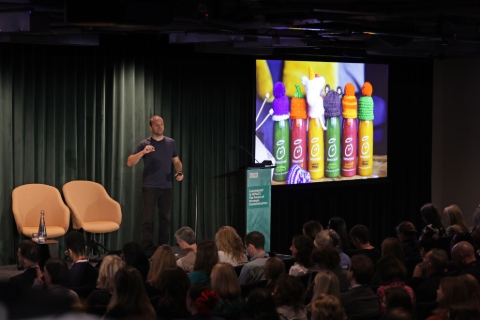
Appearing on stage the day after Influence published its interview with him, Peach said modern leaders need to adapt to constant change, prioritise perspective, foster candid collaboration and embrace radical ownership.
“You as leaders are about to take on problems that you've never solved before, to solve challenges you've never had to challenge before,” he warned. “There's going to be more change and advancement in the next 10 years than there's been in the previous 100.
“We’re going to have to act like CEOs in all levels of an organisation,” he added, hailing Innocent’s ethos of celebrating failure to learn to take risks and innovate.
This entrepreneurial mindset of “if you believe in something, go for it even when those around you disagree” – was proved by the smoothie brand’s Big Knit charity campaign. The employee, whose idea met resistance from Innocent’s founders, launched it because he was 70% sure of success. It has become one of the UK’s most successful marketing campaigns and raised tens of millions of pounds for Age Concern.
Organisations need a clear vision and effective communication of their purpose he added. To prove the point, Peach displayed his first campaign for Uber, which he modestly described as “the worst piece of marketing I’ve done”. Why? Because he was trying to scale an app across Europe with a list of cultural values but no description of the business vision.
“Clarity is the single biggest thing you can give anyone in an organisation. You bring clarity by stopping and prioritising perspective,” he said.
As a solo adventurer, Peach also drew parallels between scaling mountains on a bicycle to the challenge of modern leadership. “When we step back as leaders and see that bigger picture is the priority, not ticking off a list, we can be more effective and bring people on the journey.”
AI: Opportunity, disruption and the future of work
“You will know more about AI after this session than most people in your business,” Priya Lakhani promised the audience as she stepped on stage.
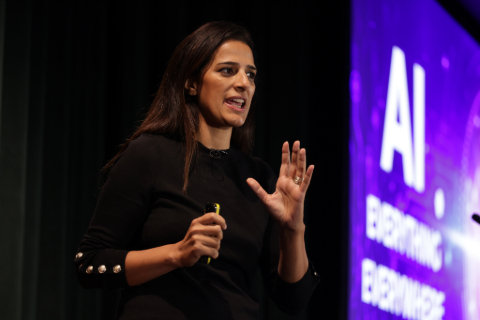
Lakhani, the founder and CEO of Century Tech, quoted research that shows that while AI was a top priority for CEOs last year, there’s a significant knowledge gap of the issue among the C-suite. “Around 95% businesses are failing to achieve ROI from AI investments,” she added.
In pledging to get “under the hood” of AI, Lakhani back to basic guide to the technology, provided an antidote to the near-daily and often dystopian newspaper headlines that claim that we’re all about to lose our jobs or worse.
Explaining that data is the “lifeblood” of artificial intelligence, she used real and hypothetical examples to explain AI’s underlying mechanisms including machine learning, image recognition, and generative and non-generative AI.
There is of course the dark side to AI, including deep fake videos and voice-scamming software. Against the backdrop of a geopolitical war between the USA and China, the government must balance innovation with regulation, particularly when wanting to attract and retain startups or scale ups to provide a jobs boom.
While the potential for AI to manipulate public opinion and communications can’t be underestimated, that doesn’t absolve PR from making informed and ethical decisions or asking critical questions about its use.
For PR professionals wanting to adopt AI tools, Lakhani – who was awarded an OBE in 2014 for services to business – was clear: “You cannot wait for regulation because regulation chases innovation.” (She co-wrote the UK government's review of AI last year.)
She did however urge organisations against developing “useless” AI strategies, advocating instead for implementing AI within existing business, growth and communication strategies.
“There is no point having an AI strategy sat in a silo … AI is not a tool on its own,” she said, reminding the audience to use their expertise tools to focus on outcomes they want to achieve, their goals and the problems to overcome.
And as for those predicted job losses? Lakhani is not convinced. Leaders should look at how AI can create efficiencies that increase capacity.
Future-proofing leadership: Building multi-generational teams that drive impact in the age of gen Z
Speaker Josephine Hansom helps organisations future-proof their business by better understanding the next generation. She explained how the workplace experiences of gen Z differ enormously to their older colleagues (baby boomers, gen X and millennials).
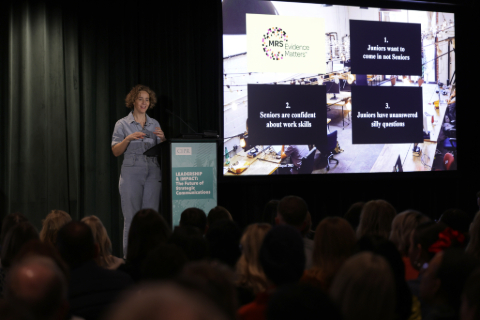
Few have fixed desks stacked with personal belongings, learning on the job is more difficult in the hybrid workplace, and they’ve entered a world where 40% of workers are checking emails before 6am and almost a third are online at 10pm.
For gen Z, work is not their identity. Research shows that 72% of gen Z would rather grow individually as people and learn skills themselves than manage a team.
“They've watched middle managers do the 60-hour work week with minimal reward and burnout. Seven out of 10 see middle management as high stress, low reward,” said Hansom, who is board member of the Market Research Society and a former managing director of Youthsight.
“That’s not gen Z being lazy. They’re looking at what’s going on and thinking that it’s not worth it … Over half of gen Z would say no to a promotion that they didn't ask for.”
It reflects a trend towards career minimalism, where an employee focuses on doing their job well without going above and beyond. Given this and the lack of career paths, rewards (gen Z are at a disadvantage of early career salaries not keeping up with house prices) and a “broken hybrid model”, how can you motivate the next generation to do their job properly and stick with it in the long term when they’re having to live for the moment?
Leaders who want to build a positive company culture need to be honest about the “new reality of uncertainty” and provide the training that junior colleagues need to learn.
“Be the person that you want others to see when you don't think they're looking, said Hansom. “If you want juniors to ask questions, you ask questions. If you want them to admit they don't know how to do something, you admit that too. And if you want flexibility and boundaries to be respected, you model them as well, rather than just approving them on paper.”
Change: Stepping in, not stepping back
Employees are facing 13 changes per year on average, said Naomi Goodman, head of change and employee engagement at MHP Group, to gasps and nods of familiarity from the audience in almost equal measure.
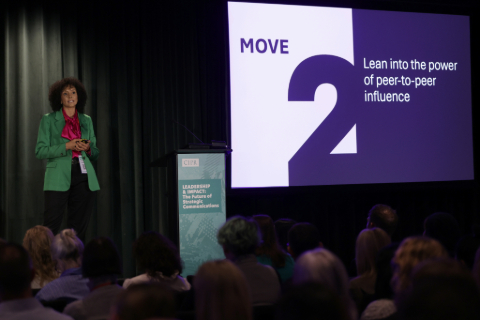
Goodman introduced the three sides of change – the organisation, those people impacted, and “us as individuals … how we, as communications professionals, choose to step into the game of change.”
With the world running in a state of perma-crisis, change is the constant backdrop to modern day business. Communications professionals tasked with equipping employees to embrace change do so against a wall of “change fatigue” and distrust of change programmes. Yet they need to act as barometers to understand if or how the relentless noise around us will affect business.
In sharing 10 questions that change leaders could use to understand the impact of external impacts on people and the business, Goodman called on the delegates to “be the person who gets stakeholders together to understand if the external noise will impact the organisation, who asks the right questions about the business and the impact on people, to help them assess the impact and decide how to respond.”
She advocates the role that informal networks play in organisational success and offered advice on how to identify the most influential and trusted colleagues to drive change on the ground.
Change practitioners, who are often expected to do more with fewer resources, to work smarter and harder, can’t ignore their own wellbeing either.
“It doesn’t matter how brilliant we are at our job or how hard we work, every single one of us is replaceable. The organisation doesn’t suffer if we burn out,” she said.
Goodman is a qualified meditation teacher who believes in the power of the breath. Acknowledging how change can ignite fear and anxiety in employees and senior leaders, she demonstrated how to visualise a protective circle – dubbed “boundary empathy” – to help comms professionals in their conversations with them.
“Letting everyone’s energy bounce off me, rather than absorbing it, allows me to lead with calm, empathy and compassion,” she said.
Confidence: The ultimate team superpower
A smiling Kira Matthews bounded on to stage with all the confidence and gravitas that you’d expect – or at least hope – from a mindset and confidence coach. Her talk, peppered with quips and one-liners, had a serious message: we need to lead with confidence and take care of ourselves while doing it.

Matthews, the creator of the No Room for Doubt podcast, helps leaders, employees and freelancers overcome self-doubt to achieve their goals. She has worked with brands including Adidas, Dermalogica and Topicals.
She shared the story of Fred van der Weij, the inventor of the air fryer, to explain the challenges of leading with confidence. Van der Weij faced financial strain and family disconnection while chasing his dream. Modern leaders can’t afford to do that; they need to understand the importance of including their team in the vision and supporting them through change.
“It's not enough for a leader to just do good work. You must also support your team in doing that work,” she said.
“When a visionary leader leaves their team to fend for themselves, it creates a culture of insecurity, competition and the kind of glass door reviews that go viral for all of the wrong reasons.”
They need to manage their inner doubts and fear of failure if they want to have hard and challenging conversations with their teams, she added.
“Your inner critic won’t give you an accurate reflection of your achievements, abilities or what's possible for you ... so stop looking to it for advice,” she said, while also urging the audience to reframe negative stories more positively to build confidence and see resistance within teams as an opportunity for connection. Most of all, use facts to ground oneself, manage stress and maintain clarity, she added.
Like Peach earlier in the day, Matthews champions leaders to create a culture where failure is celebrated and lessons are learned.
“When failure becomes a banned word, people become afraid of doing anything wrong. You drive out innovation and taking risks to try new things.”
Wired for wisdom in a world that won’t slow down
Dr Jack Lewis, a neuroscientist, TV presenter and author, delved into the power of the brain. His talk focused on the practical applications of neuroscience in everyday life and the importance of critical thinking in maintaining cognitive abilities in the modern tech-heavy world.
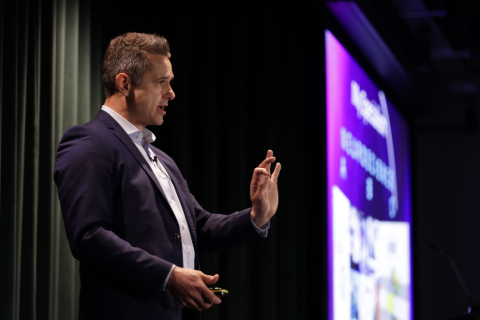
Just as Goodman had asked the audience to imagine a situation which left them awake at 4am, Lewis explained why sleep is so important for brain health and the role it plays in memory consolidation, brain repair, and the removal of toxins.
“Gradually increasing sleep duration by 15 minutes a month to reach the seven or eight hours needed can improve long-term cognitive function,” he said.
Lewis, who was interviewed by Influence in October and helps businesses use neuroscience to understand people’s perceptions of brands, explored decision-making and the brain’s reward pathway. He described how the ventral tegmental area (VTA) and nucleus accumbens drive pleasure and motivation, shaping our choices based on past experiences.
“The main purpose of the reward pathway is to create a model of how the world works, and it wants to minimise surprises,” he explained. “If pitching for business, save the brilliant phenomenon that you can offer (and that your competitors can't) until the [prospective client] thinks they've heard it all. Add it right at the end for maximal impact on their reward pathway.”
Lewis explained neuroplasticity and how our brain changes according to how we choose to spend our time. Spoiler: for those of us glued to our smartphones, research shows reduced attention span, memory retention, and empathy.
“These are incredibly important skills … with the brain it’s use it or lose it,” he added, pointing to how heavy media multitasking – such as scrolling while watching TV – can increase distractibility and decrease cognitive performance.”
Lewis concluded his session by cautioning against overreliance on generative AI, saying that it may erode critical thinking and professional competence. “Balance technology use with deliberate mental effort to preserve and enhance brain function,” he urged the audience.
The recipe for successful leadership
Karen Blackett, a former UK president at WPP, gave the final speech of the day. She likened successful leadership to a recipe that evolves as leaders add ingredients from their experiences. She identified four key factors impacting leadership: adapting to the “Vuca world” (volatility, uncertainty, complexity, ambiguity), embracing technological change, understanding and flexing communication styles, and prioritising self-care.
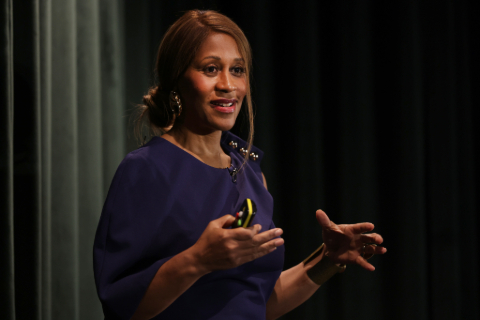
“Technological advancements demand constant learning,” she said, introducing the concept of the “learning dip,” where performance temporarily drops when acquiring new skills, leading to fears of incompetence and loss of identity.
Blackett is non-executive director at both Diego and the Foreign, Commonwealth & Development Office (FCDO). Personal branding is central to her leadership philosophy; she encouraged delegates to define their brand through values, personality, and behaviour, citing examples like Steve Jobs and Dame Carolyn McCall.
“Authenticity and trust are crucial, with trust built through credibility, reliability, empathy, and self-orientation,” she said explaining the idea of the “trust equation”.
Organisations need diversity and inclusion to grow, she added. Leaders need to expand their networks beyond similar backgrounds to gain diverse perspectives. “This improves governance and decision-making … Covering – where individuals suppress aspects of themselves to fit in – harms productivity and happiness.”
Blackett, who received an OBE in 2014 for services to media and communications and a CBE in January for services to advertising and the creative industries, believes that effective communication requires leaders to adapt their style to different audiences while also remaining authentic.
“No two leaders share the same recipe. Our differences are what makes us better communication professionals,” she said.
Empathy is vital, Blackett explained, especially in multi-generational teams, while inclusive leadership involves humility, gratitude, positive body language, and sharing recognition.
“I’m an advocate for Lomo (love of missing out) to recharge and avoid burnouts,” she said, echoing other speakers’ claims that success isn’t possible without self-care. “I know that we always want to be at every event and to not miss out, but sometimes we have to take a break and look after ourselves.”
The breakout sessions
During the day delegates who attended in person had the choice to attend two of six breakout sessions:
From Insight to Impact: The Financial Times’ journey to AI confidence
Lucy Holliday, senior employee communications manager at the FT, explained how the media powerhouse empowered thousands of employees to embrace AI with confidence.
Non-executive Director – a panel discussion
Farzana Baduel, CEO and co-founder of Curzon PR and CIPR President-Elect 2025, chaired a discussion with Andy West, managing consultant of Westofcenter Consulting, Bridget Aherne, director of Bridget Aherne Communications, and Lornette Harley, associate director at MSL, which explored the journey to becoming a non-executive director.
What Journalists Really Need: Strong visuals and trusted experts in the AI era
Craig Gunn, managing director of PA Media Assignments, explained how authentic imagery and human-vetted expertise underpin credible reporting and audience engagement.
Comms to CEO - A panel discussion
Noha Al Afifi, deputy CEO of Arthritis Action, chaired a panel discussion that explored the unique and transferable skills that comms leaders bring to the C-suite. Three chief executives - Annette Spencer from the Association of Corporate Treasurers, Koray Camgöz from the Taylor Bennett Foundation, and Darren Caplan of the Railway Industry Association – spoke about the professional development paths that have supported their journey so far and the challenges they faced in stepping into the CEO role.
Daisy v the Scammers: The AI granny who started a national conversation on fraud
From Virgin Media O2, Luke Stallard head of corporate communications, and Erin Hayward, the company’s senior communications manager, transported the audience behind the scenes of their CIPR Excellence Award-winning campaign. The smart, insight-led approach to fraud awareness, captivated audiences and changed consumer behaviour.
Navigating your own path: Independent practitioners lead the way
Is it worth becoming an independent practitioner in the current climate? Sara Naylor, co-chair of the CIPR Independent Practitioner Network, was joined on stage by three comms professionals – Kayleigh-Anne Soryal, communications consultant at Love Comms; Vishnee Sauntoo, senior communications strategist and founder of VS Comms; and Ben Veal, founder of Second Mountain Comms – to offer top tips, share knowledge and answer that question.
Richard Dunnett is a journalist and content specialist, the web manager of Influence and head of content at Meet the Leader. He previously held senior publishing roles at Director (the business magazine of the Institute of Directors), Sky TV, various lifestyle magazines and within the internal comms department of the John Lewis Partnership.
Further reading
The award-winning PR campaign helping GPs better serve veterans
As John Lewis Christmas ad lands, how to create a multi-generational PR campaign
Forget screens, gen Z wants to network in person. Will senior PRs help them?



